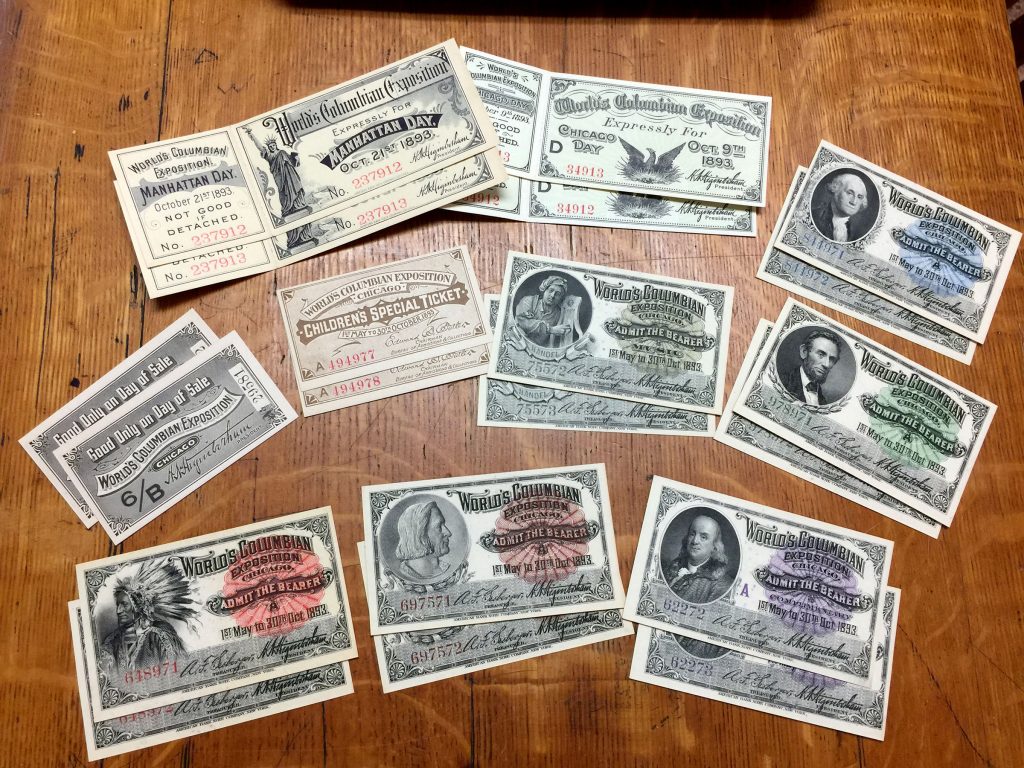Volume 3, Issue 40
The collections within the Department of History contain newspaper clippings, genealogies, published histories, and photographs, but a number of interesting artifacts and ephemera items serve as a window into Orleans County’s material culture. This photograph shows a collection of souvenir tickets from the 1893 World’s Columbian Exposition held in Chicago, Illinois. The collection once belonged to Dr. Frank Haak Lattin, a dealer in natural specimens, a physician, and Assemblyman from New York.
Nearly 125 years ago, the United States prepared to celebrate the 400th anniversary of Christopher Columbus’s arrival in the new world in 1492. In order to host this massive event, 200 new but temporary buildings were constructed upon 600 acres of land using neoclassical architecture. A large central pool represented the long cross-Atlantic voyage of Columbus four centuries prior, a true symbol of American exceptionalism. Dedicated on October 21, 1892, the fair officially opened to the public on May 1, 1893 and ran through October 30, 1893. In addition to the celebration of this monumental occasion, the fair served as a representation of Chicago’s rebirth after the Great Fire in 1871; the city rising from the proverbial ashes.
Although centered in Chicago, the World’s Exposition featured numerous connections to Western New York and Orleans County. Frederick Douglass, once a resident of Rochester, was selected to serve as the national delegate for Haiti. Frederick Law Olmsted, who designed the University of Rochester campus and countless parks in the Western New York area, was responsible for the layout of the fairgrounds. The Mines & Mining Building used to house representations of America’s rich coal, oil, and steel resources was designed by Solon Spencer Beman, the same man who later designed the Pullman Universalist Church in Albion. Some historians have argued that the World’s Fair in 1893 was the first time that the term “Windy City” was used to refer to the city of Chicago. Charles Anderson Dana, who as a boy lived at Gaines Basin and later served as the editor of the New York Sun, was credited with coining that phrase.
Two of Orleans County’s own were present at the Fair, overseeing exhibitions in the Anthropology building. Frank Hamilton Cushing (Barre), the noted anthropologist and ethnologist who specialized in the study of the Zuni Indians in New Mexico, and Frank Haak Lattin (Gaines), a purveyor in natural specimens and publisher of The Oologist, both participated in the Exposition. Lattin’s exhibit of natural specimens occupied nearly 2,000 square feet of space and his participation in the Fair provided him with the opportunity to purchase the collection once belonging to Col. Ezekiel Jewett consisting of over 50,000 shell specimens.
Visitors were provided with a number of different tokens and keepsakes to take away from the Fair. Coins and medallions were cast for distribution, but others chose to hold on to the tickets that guaranteed them entrance into the Exposition. Approximately 60,000 individuals were provided with “portrait tickets” that featured images of Abraham Lincoln, George Washington, Benjamin Franklin, Christopher Columbus, Georg Friedrich Handel, and an image of a Native American chief based largely on stereotypes. Each image was meant to represent a distinct period in American History. These “season tickets” ensured exhibitors ongoing access to the Exposition between May and October, which would explain why Lattin retained at least one set of tickets; it is presumed that his wife was provided the second set. Since these tickets were used for ongoing access to exhibit areas, these slips of paper were often torn, bent, folded, or dropped in puddles of water resulting in wrinkles and splotched ink, but these tickets remain in excellent condition.
Also included in the set are two one-day tickets purchased at a cost of $.50, or approximately $14.00 today. These guaranteed visitors access to the Fair on the same day the ticket was purchased; children received “special” tickets at half-price. Other tickets, like the “Manhattan Day” and “Chicago Day” tickets provided limited access to special events during the Fair. On Manhattan Day, New York’s finest including the president of Columbia University, the mayor of New York City, ex-mayors, congressmen, clergy, judges, and commissioners all enjoyed fine dining and entertainment; Chicago Day, on the other hand, set a world record for event attendance with 751,026 people participating.
Of course, the Columbian Exposition was a place of many firsts, introducing Quaker Oats, Shredded Wheat, Pabst Blue Ribbon, and the Ferris wheel to American society, the Fair also gave rise to America’s first serial killer, H. H. Holmes, who was recently suspected of being Jack the Ripper.
We are remarkably fortunate that pieces of history like this still exist locally!


